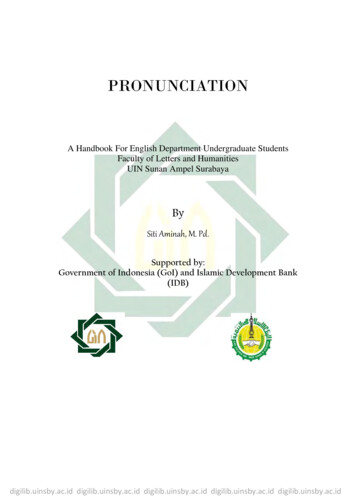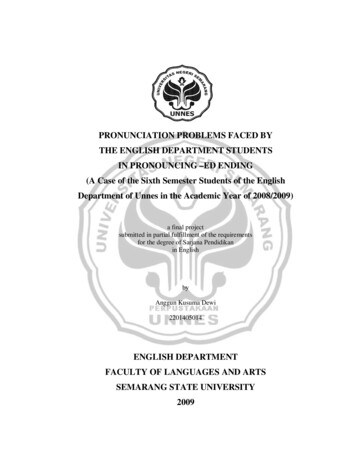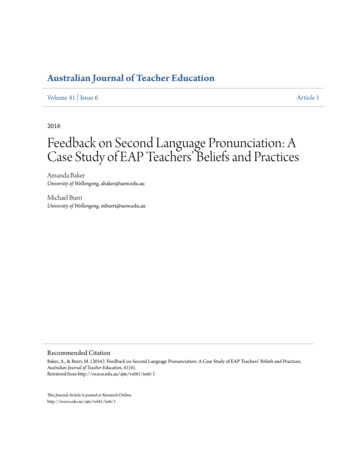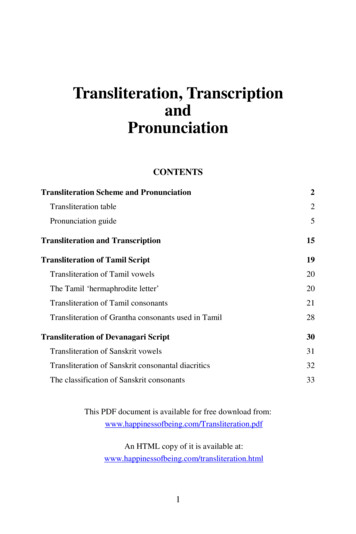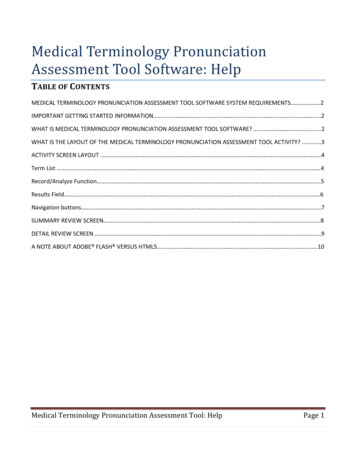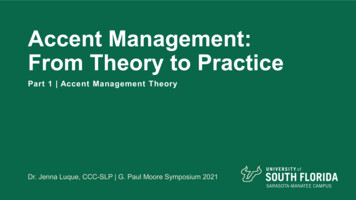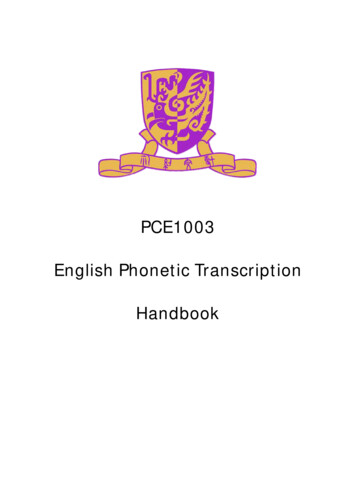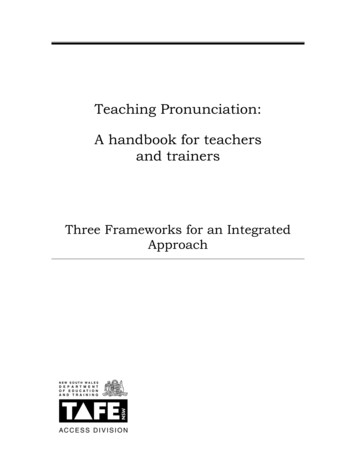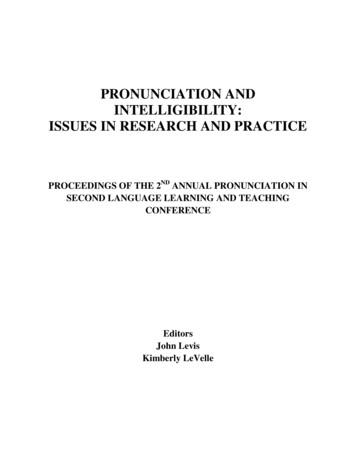
Transcription
PRONUNCIATION ANDINTELLIGIBILITY:ISSUES IN RESEARCH AND PRACTICEPROCEEDINGS OF THE 2ND ANNUAL PRONUNCIATION INSECOND LANGUAGE LEARNING AND TEACHINGCONFERENCEEditorsJohn LevisKimberly LeVelle
ACKNOWLEDGEMENTSThe papers in this volume were presented at the Pronunciation in Second Language Learning andTeaching conference held at Iowa State University on September 10 – 11 of 2010.We thank Murray J. Munro, the invited speaker, for his enthusiastic participation. We also thankthe Intensive English and Orientation Program as well as the Department of English at IowaState University for their financial support.Copyright for abstracts and papers written for the Second Annual Conference on Pronunciationin Second Language Learning and Teaching (PSLLT) is retained by the individual author/s, whoshould be contacted for permission by those wishing to use the materials for purposes other thanthose in accordance with fair use provisions of U.S. Copyright Law.2011TESL/Applied LinguisticsIowa State UniversityPronunciation for Second Language Learning & Teachingi
PRONUNCIATION AND INTELLIGIBILITY: ISSUES IN RESEARCH ANDPRACTICEProceedings of the2nd Pronunciation in Second Language Learning and Teaching ConferenceSeptember 10-11, 2010Iowa State UniversityPronunciation and Intelligibility: An Overview of the ConferenceJohn Levis and Kimberly LeVelle . 1Listener Reactions to Accented SpeechIntelligibility: Buzzword or buzzworthy? (Plenary)Murray Munro . . 7(Un)Intelligibility TalesLaura Hahn and Patricia Watts. 17The Interlanguage Speech Intelligibility Benefit: The Case of Arabic-Accented EnglishGhazi Algethami, John Ingram, and Thu Nguyen . 30Language and Nonlanguage Factors Affecting Nonnative Undergraduate Students’ Reaction toITAsEdna Lima . 43Assessing Speech Intelligibility: Experts Listen to Two StudentsJohn Levis . 56Pedagogical ApproachesUpstream DestressingWayne Dickerson . 70ESL Teachers and Pronunciation Pedagogy: Exploring the Development of Teachers' Cognitionsand Classroom PracticesAmanda Baker. 82An Integrated Approach to Pronunciation: Listening Comprehension and Intelligibility in Theoryand PracticeMarnie Reed and Christine Michaud . 95Pronunciation Learning Strategies that Improve ESL Learners’ LinkingVeronica G. Sardegna . 105Pronunciation for Second Language Learning & Teachingii
Using Mobile Technologies for Synchronous CMC to Develop L2 Oral ProficiencySarah Huffman . 122Acquisition and DescriptionThe Pronunciation of /s/ in Complex Onset and Coda Clusters in Somali-Accented EnglishEttien Koffi. 130Acquisition of L2 Phonology in Advanced Learners: Does Instruction Make a Difference?Anita Saalfeld. 144Vowel Spaces in Bilingual Haitian American KindergartnersStacey Wallen and Robert Fox . 153The Impact of Computer Assisted Pronunciation Training on the Improvement of VietnameseLearner Production of English Syllable MarginsPamela Pearson, Lucy Pickering, and Rachel DaSilva . 169Students’ Awareness of Spanish Spirantization Allophonic RulesManuela González-Bueno and Marcela Quintana-Lara . 180Computer Assisted Pronunciation Learning of French /u/ and /y/ at the Intermediate LevelViviane Ruellot. 199Pronunciation for Second Language Learning & Teachingiii
Levis, J. & LeVelle, K. (2011). Pronunciation and intelligibility: An overview of the conference. In. J. Levis & K.LeVelle (Eds.). Proceedings of the 2nd Pronunciation in Second Language Learning and TeachingConference, Sept. 2010. (pp. 1-6), Ames, IA: Iowa State University.PRONUNCIATION AND INTELLIGIBILITY:AN OVERVIEW OF THE CONFERENCEJohn Levis, Iowa State UniversityKimberly LeVelle, Iowa State UniversityA generally accepted goal of pronunciation pedagogy is to help learners achieve a comfortablyintelligible pronunciation rather than a native-like one. But what should this goal look like in thekinds of research studies we conduct, in our classroom practice, and in the creation of self-studyand computer assisted pronunciation materials? Which elements of pronunciation are mostimportant in achieving a comfortably intelligible pronunciation? What principles can helpteachers make decisions regarding intelligibility?The 2nd Pronunciation in Second Language Learning and Teaching Conference was held at IowaState University on September 10-11, 2010 with the goal of exploring some of these questions.Research was presented that concerned not only English pronunciation, but also Spanish, Frenchand Chinese pronunciation, providing a valuable forum for bringing together researchers indifferent areas who have common concerns. To give a flavor of the overall variety of theconference sessions, the conference schedule is reproduced below. Those sessions that are inbold are included in the Proceedings.2010 Conference ScheduleFriday, September 109:00 a.m.Intelligibility talesLaura Hahn and Patricia Watts (University of Illinois)9:30 a.m.The interlanguage speech intelligibility benefit: The case of Arabicaccented EnglishGhazi Algethami (University of York, UK)10:00 a.m.Integrated pronunciation: Listening comprehension andintelligibility in theory and practiceMarnie Reed (Boston University)10:30 a.m.Break10:50 a.m.The pronunciation of /z/ in coda clusters in Somali-accented EnglishEttien Koffi (St. Cloud State University)11:20 a.m.The role of word familiarity and word context on English vowelintelligibilityRon Thomson (Brock University, Canada)11:50 a.m.Don’t take that tone: Critical errors in lexical tone acquisitionAlina Twist, Alison Blodgett, Jessica Bauman, Melissa Fox, AntonRitting, Matt Winn (University of Maryland CASL)
John Levis & Kimberly LeVellePronunciation and Intelligibility12:20 p.m.Pronunciation learning strategies that improve ESL learners’linkingVeronica Sardegna (University of Texas at Austin)12:50 p.m.Lunch2:15 p.m.[Plenary]Intelligibility: Buzzword or buzzworthy?Murray Munro (Simon Fraser University, Canada)3:30 p.m.Destressing: Another step toward natural speechWayne Dickerson (University of Illinois)4:00 p.m.Pronunciation pedagogy: An exploration of teacher learning andclassroom practicesAmanda Baker (Georgia State University)4:30 p.m.Towards more effective L2 pronunciation instruction: Maximizingaccuracy and oral fluencyBertha Chela-Flores (Universidad Simon Bolivar, Venezuela)6:30-9:00 p.m.Conference dinnerSaturday, September 119:00 a.m.The role of technology in pronunciation teaching: The use ofbiovisual feedback in improving Vietnamese learners’ production ofEnglish syllable marginsLucy Pickering (Texas A & M), Pamela Pearson & Rachel DaSilva (Georgia State University)9:30 a.m.Where is intelligibility in machine recognition of non-native speech?Brian Teaman (Osaka JoGakuin College, Japan)10:00 a.m.Computer-assisted pronunciation learning of French /u/ and /y/ atthe intermediate levelViviane Ruellot (Western Michigan University)10:30 a.m.Break10:50 a.m.L2 speakers’ impressions of the roles of accent and intelligibility afterseven years in an ESL environmentTracey Derwing (University of Alberta, Canada)11:20 a.m.Acquisition of L2 phonology in advanced learners: Does instructionmake a difference?Anita Saalfeld (University of Nebraska-Omaha)Pronunciation for Second Language Learning & Teaching2
John Levis & Kimberly LeVellePronunciation and Intelligibility11:50 a.m.Empowering students to develop their own voice: An achievable goalJoanna Smith (Unitec, New Zealand)12:45 p.m.Lunch1:45 p.m.PostersThe perception and production of English word-final alveo-palatals byKorean L1 learners of EnglishAmanda Huensch (University of Illinois)Funny marks in French? C-cédilles and first semester learnersJessica Sturm (Purdue University)Vowel production abilities of Haitian-American childrenStacy Wallen (Georgia State University) & Robert Fox (Ohio StateUniversity)Students’ awareness of Spanish spirantization allophonic ruleManuela Gonzalez-Bueno & Marcela Quintana-Lara (Universityof Kansas)Intelligibility in second language communication: A two-way streetNicole Eustice (University of Iowa)Nonlanguage factors affecting nonnative undergraduate students’reaction to ITAsEdna Lima (Iowa State University)The acquisition of aspiration in Serbian EFL learnersBiljana Cubrovic (University of Belgrade, Serbia)Using mobile technologies for synchronous CMC to develop L2 oralproficiencySarah Huffman (Iowa State University)3:00-4:30 p.m.Interactive panel discussionWhat really affects and improves intelligibility?Moderated by John Levis5:45-8:30ReceptionThe papers in the proceedings are divided into three sections that have broadly similar themes.There are five papers in the first section, all generally related to Listener Reactions to AccentedSpeech, including discussions of intelligibility and sociolinguistic reactions such as irritation.The second section also includes 5 papers and is titled Pedagogical Approaches. Finally, the lastsection includes six papers on the general theme of Pronunciation Acquisition and Description.Pronunciation for Second Language Learning & Teaching3
John Levis & Kimberly LeVellePronunciation and IntelligibilityListener Reactions to Accented SpeechThe first section, Listener Reactions to Accented Speech, starts with the plenary address byMurray Munro of Simon Fraser University. “Intelligibility: Buzzword or buzzworthy?”examines the contention put forth in an opinion article in Applied Linguistics (Rajogapolan,2010) that intelligibility is a politically charged concept that sounds good but is ultimatelycounterproductive in relation to research and teaching. Munro provides evidence thatintelligibility has a long history both in and outside of linguistics, and that intelligibility is alsoan issue that has real-world implications in fields as diverse as aviation and public serviceencounters.In “(Un)Intelligibility Tales,” Laura Hahn and Patricia Watts discuss narratives provided byteachers and students about times they experienced loss of intelligibility. Most describedexchanges involving NS-NNS interactions or those between two NSs. They analyze theexchanges according to the features of the speech exchange that caused the loss of intelligibility,how the confusion was repaired, and the role context played in remedying the loss.Ghazi Algethami, John Ingram, and Thu Nguyen, in “The interlanguage speech intelligibilitybenefit: the case of Arabic-accented English,” looked at the Interlanguage Speech IntelligibilityBenefit, the hypothesized intelligibility advantage L2 listeners have over native listeners whenthey listen to speakers who share their native language. They found no significant differencebetween L1 Arabic speakers and native English speaking listeners when listening to Arabicaccented speech. They interpret these findings in light of previous findings and suggest thatphonetic features of L2 speech more strongly influence listeners’ perceptions than nativelanguage.In “Language and Nonlanguage Factors Affecting Nonnative Undergraduate Students’ Reactionto ITAs,” Edna Lima investigated the perceptions of international undergraduate studentstoward international teaching assistants (ITAs). In a matched-guise study, students enrolled infirst-year composition classes watched a short video-taped lecture with three guises. Significantresults were found for accent and speaker likeability.Finally, John Levis provides a collection of themes that arose during a panel discussion ofpronunciation experts from around the world in “Assessing Speech Intelligibility: Experts Listento Two Students.” The panel and audience listened to recordings of the English free speech andread speech of two students, a Spanish speaker and a Korean speaker. Panelists discussed theissues that affected the speech intelligibility of the two students. Four themes are examined:The role of listeners’ experience, the features that most impacted intelligibility, the tendency toattribute loss of understanding to accent regardless of the true cause, and the problems withassessing using tasks that employ read speech.Pedagogical ApproachesThe second section of the proceedings includes a variety of papers that address pedagogicalconcerns. In “Upstream Destressing,” Wayne Dickerson argues that destressing, a well-attestedfeature of English pronunciation after the sentence focus, also occurs in phrases in which two orPronunciation for Second Language Learning & Teaching4
John Levis & Kimberly LeVellePronunciation and Intelligibilitymore strongly stressed syllables precede the sentence focus. He discusses how de-stressing thestrongly stressed syllable immediately preceding the focus provides an environment in which thefocused syllable can be heard more clearly and provides pedagogical suggestions for making useof this pattern in teaching focus.Amanda Baker discusses how teachers’ knowledge and beliefs develop and the ways in whichthose beliefs affect their classroom practice in “ESL Teachers and Pronunciation Pedagogy:Exploring the Development of Teachers' Cognitions and Classroom Practices.” She examinesthe cognitions and practices of five experienced ESL teachers and finds that training inpronunciation pedagogy strongly affects not what they know but their confidence. In addition,their own language learning background, teaching experience and work with other teachersinfluence their approach to pronunciation.In “An Integrated Approach to Pronunciation: Listening Comprehension and Intelligibility inTheory and Practice,” Marnie Reed and Christina Michaud argue that the relationshipbetween speaking and listening should be understood in terms of an auditory feedback loop, inwhich production facilitates perception. Four components are proposed for pronunciationteaching to accompany and reinforce other elements of language teaching: connected speech,suprasegmentals, inflectional morphology, and segmentals. Suggestions are given for what suchan approach might look like in the classroom.Veronica G. Sardegna, in “Pronunciation learning strategies that improve ESL learners’linking,” explores how teaching pronunciation learning strategies improved linking within andacross words. Teaching strategies led to initial and long-term improvement for all groups ofstudents. The pronunciation learning strategies that were used are examined in detail andpedagogical implications are given for the use of strategies especially in regard to the teaching oflinking.In “Using Mobile Technologies for Synchronous CMC to Develop L2 Oral Proficiency,” SarahHuffman moves away from a narrow focus on pronunciation to explore how ComputerMediated Communication (CMC) using mobile technologies can help promote oral proficiency.She explores how multimedia mobile technologies have great promise in helping learnersdevelop their L2 oral proficiency. The researcher also provides points to consider to make theimplementation of mobile technologies more successful in teaching L2 oral language andsuggests future research avenues.Pronunciation Acquisition and DescriptionThe last set of papers address descriptions of learner pronunciation and the way pronunciation isacquired. In “The Pronunciation of /s/ in Complex Onset and Coda Clusters in Somali-AccentedEnglish,” Ettien Koffi describes how /s/ in complex onset and coda clusters patterns in thespeech of Somali learners of English, a major immigrant population in Minnesota, a midwesternUS state. He first describes how /s/ contributes to accentedness, and then explains the patternsusing two phonological principles, the Sonority Sequencing Principle and the Coda Condition.Pronunciation for Second Language Learning & Teaching5
John Levis & Kimberly LeVellePronunciation and IntelligibilityAnita Saalfeld analyzes the acquisition of Spanish stress in “Acquisition of L2 phonology inadvanced learners: Does instruction make a difference?” She replicated previous research on theacquisition of Spanish stress with a group of intermediate learners in a Spanish phonetics courseand a control group in another non-phonetics oriented Spanish course. Her results suggest thatwhen students can self-enroll in courses focusing on pronunciation, those who needpronunciation instruction the most are more likely to avoid classes that include phoneticsinstruction.In “Vowel Spaces in Bilingual Haitian American Kindergartners” Stacey Wallen and RobertFox examine the vowels used by monolingual and bilingual Haitian American kindergartners.Because such bilingual speakers are often identified for help with communication disorders whenthey may simply have a communication difference, it is important to identify whether such helpis necessary. They found that vowel production of Haitian American kindergartners differedfrom bilingual Haitians only in production of /o/, and that there were no significant differences inthe vowels of bilingual Haitian American children and native English speaking controls.In “The impact of computer assisted pronunciation training on the improvement of Vietnameselearner production of English syllable margins,” Lucy Pickering, Pam Pearson, and RachelDaSilva look at how computer assisted pronunciation training can be used to improve thepronunciation of Vietnamese learners of English at syllable margins. Thirteen intermediateVietnamese students took part in eight 30-minute tutoring sessions where they used spectrogramsof their own speech to compare their production to the prerecorded spectrograms. Themethodology proposed in the study is put forth as a model for other pedagogical interventionsbased on the reactions of both teachers and students.Manuela González-Bueno and Marcela Quintana-Lara examine the extent to which L2Spanish learners who vary in language proficiency are aware of how Spanish voiced stopsbecome fricatives in particular environments in their paper“Students’ Awareness of SpanishSpirantization Allophonic Rules.” The results indicate that proficiency is strongly related toawareness, with intermediate learners beginning to show awareness, and that the development ofawareness starts earlier for velars and dentals than for bilabials. In production, the sounds notfound in English (velar and bilabial fricatives) were produced more frequently than dentalfricatives (a sound found in English).In “Computer Assisted Pronunciation Learning of French /u/ & /y/,” Viviane Ruellot exploreshow visual feedback improves the pronunciation of French /u/ and /y/ in the intermediate-leveladult learners of French. Because /y/ is not an English sound, learners will not acquire it withoutsufficient exposure. Even though visual reinforcement has been successful for otherpronunciation features, this was not the case for these vowels.ReferencesRajagopalan, K. (2010). The Soft Ideological Underbelly of the Notion of Intelligibility inDiscussions about ‘World Englishes.’ Applied Linguistics, 31, 465-470.Pronunciation for Second Language Learning & Teaching6
Munro, M. J. (2011). Intelligibility: Buzzword or buzzworthy?. In. J. Levis & K. LeVelle (Eds.). Proceedings of the2nd Pronunciation in Second Language Learning and Teaching Conference, Sept. 2010. (pp.7-16),Ames,IA: Iowa State University.INTELLIGIBILITY: BUZZWORD OR BUZZWORTHY?Murray J. Munro, Simon Fraser UniversityIntelligibility is a much-touted concept in current research on second-language pronunciationteaching and in discussions of World Englishes. Some recent commentary has even asserted thatthe term has become a meaningless buzzword. However, interest in this very central aspect oflanguage communication has a long history. Over a century ago, Henry Sweet’s (1900) guide topractical language study made numerous references to it, and throughout the 20th century it hasbeen of interest not only to language teachers, but also to a wide range of researchers andpractitioners in the speech and communication sciences. Intelligibility is a fundamentalrequirement in human interaction, while the costs of unintelligibility range from minorinconvenience to matters of life or death. Although a focus on intelligibility has importantrepercussions for language teaching, social interaction, identity, and even human rights, definingthe concept and determining its underpinnings have posed major challenges for researchers. Infact, many aspects of the notion remain poorly understood. This discussion examines the originsand significance of the construct, and identifies directions for future research on intelligibility thatwill help to establish the most effective ways of achieving it.THE INTELLIGIBILITY CONSTRUCTOf all the ideas embraced by contemporary pronunciation specialists, the notion of intelligibility as asound teaching principle seems uncontroversial. In fact, it almost enjoys the status of a hallowed pursuit.And why shouldn’t it? If, by intelligibility, we mean the extent to which utterances are understandable toa speaker’s audience, it is difficult to conceive of many realistic circumstances in which any speakerwould not want it. Language teachers therefore take it as self-evident that learners want and need todevelop intelligible speech patterns, a fact reflected in the growing interest in how that end can beachieved.Given the wide consensus on these matters, it seems astonishing to see intelligibility identified asa suspicious, politically-charged concept that cannot be justified in applied linguistics. YetRajagopalan (2010) does just that in asserting that intelligibility is merely a buzzword (p. 465) ona par with value-laden adjectives like beautiful, ugly, and primitive, which, according to him,“we have long learned to regard with suspicion” (p. 465). It is possible that his assertions arisefrom a misunderstanding of how the term intelligibility is applied by those concerned withfostering effective communication skills in ESL speakers. But whatever the explanation, hisclaims are patently false.First, let’s consider the statement that intelligibility is a buzzword – voguish and soon to beforgotten. Outside of language pedagogy, that is certainly not true. Telephone companies, soundengineers, architects, speech-language professionals, air traffic controllers and many others havebeen deeply concerned with intelligibility for many decades. The result is an accumulation of
Murray J. MunroIntelligibility: Buzzword or Buzzworthy?thousands of research papers in technically-oriented publications like the Journal of theAcoustical Society of America, many dating back to the early 20th century. If that concern hadnever existed, our daily lives would be much the poorer – telephones would not transmit speechoptimally; school classrooms would have poor acoustics, such that children would havedifficulty understanding their teachers; and patients with speech disorders would have no hope ofcommunicating effectively with family members.It is not known when intelligibility was first discussed in connection with language teaching.However, the term goes back at least as far as Henry Sweet’s (1900) book on practical languagestudy. Sweet saw intelligibility as a guiding principle in the teaching of pronunciation, which, forhim, was foundational in L2 learning. A half-century later, Abercrombie (1949) published hiswell-known article, articulating for perhaps the first time the dictum that second languagelearners should aim for a “comfortably intelligible” pronunciation rather than for a native-likeaccent. Still later in the 20th century, Gimson (1962) published his popular volume on Englishpronunciation. Revised by Cruttenden and now in its eighth edition (Gimson, 2008), it refersextensively to intelligibility, emphasizing that learners need not sound like native speakers.Gimson goes even so far as to suggest how L2 users can be understood by substituting particularconsonants for ones they are unable to produce. Meanwhile, over the past 40 years, intelligibilityhas taken its place in a wide range of pedagogical materials (e.g., Rogerson & Gilbert, 1990), aswell as in research agendas relating to World Englishes (Smith & Bisazza, 1982; Nelson, 2008)and L2 pedagogy (Munro & Derwing, 1995; in press). Intelligibility has been an active area ofdiscussion and study for a very long time. Nor is there any reason to believe that concern aboutthis topic will diminish in the near future. In short, far from being a buzzword, intelligibility is awell-established construct with a firm foundation in empirical and pedagogical traditions.Second, let’s compare intelligible with the adjectives beautiful, ugly, and primitive – all highlysubjective terms. In fact, determining the intelligibility of speech does necessitate a responsefrom an interlocutor, and the concept is evaluative in the sense that the intelligible is preferredover the unintelligible. But the difference lies in the reason for that preference. We preferbeautiful things and disprefer ugly ones as a matter of personal choice; ultimately, not muchhinges on whether our preferences are honoured. As far as I know, no one has ever died fromviewing something and judging it ugly or primitive 1. But a loss of intelligibility has at timesresulted in human tragedy. Over the past several decades, the NASA aviation reporting systemhas documented thousands of cases of communication breakdowns between pilots and air trafficcontrollers, many the result of unintelligibility. In some cases, a specific phonetic ambiguity wasdirectly tied to tragedy. Cushing (1995) provides the following example:ATC cleared the aircraft to descend “two four zero zero.” The pilot read back the clearance as,“OK. Four zero zero.” The aircraft then descended to 400 feet (122 meters) rather than whatthe controller had meant, which was 2,400 feet (732 meters). (p. 3)Tragically, as a result of this stress-related misinterpretation of two as to, four crew died. Evenmore troubling is that, according to McMillan (1998), this specific confusion is common in1Here I am excluding from consideration any of those unfortunates in Greek mythology who looked upon thegrotesque head of Medusa and were turned to stone.Pronunciation in Second Language Learning & Teaching8
Murray J. MunroIntelligibility: Buzzword or Buzzworthy?aviation. Given that sobering fact, I leave it to you – the next time you are in an airplane – toponder how comparable intelligible is to beautiful or primitive.In second language (L2) classrooms, we don’t expect to encounter life and death situations. Butthe ramifications of intelligibility loss for L2 learners are very real and very serious. Here weneed only consider the plight of immigrant language learners who find that people don’tunderstand them. Apart from the personal frustration they may feel, communication difficultiescan damage educational and career opportunities. They can also lead to negative socialevaluation, such that others avoid interactions because conversation seems a difficult chore. Andthat can lead to isolation from the host community and lost opportunities to use the L2. Denyingthat these serious consequences exist is not simply a mistaken view; it is a reckless andirresponsible position that dismisses the communicative needs of L2 learners.EMPIRICAL APPROACHES TO INTELLIGIBILITYIn our research program, my colleague Tracey Derwing and I have developed a tripartiteperspective on the study of L2 pronunciation (Derwing & Munro, 1997, 2005; Munro &Derwing, 1995). We distinguish among accentedness – how different someone’s speech seems(often from the listener’s variety), comprehensibility – the listener’s experience of how difficultthe speech is to understand, and intelligibility – how much of the speech is actually understoodby interlocutors. Of these, accentedness is the least relevant to communication because listenersquickly adjust to many divergences from their own speech patterns; many L2 speakers havestrong accents but are perfectly intelligible to their interlocutors. Intelligibility andcomprehensibility, however, are more closely tied to communicative success, and therefore meritcareful attention. One particularly important empirical finding is that it is possible for learners tobecome more intelligible or comprehensible through instruction with no noticeable change inaccentedness (Derwing, Munro & Wiebe, 1998). Furthermore, when aspects of an accent change,there is no guarantee th
A generally accepted goal of pronunciation pedagogy is to help learners achieve a comfortably intelligible pronunciation rather than a native-like one. But what should this goal look like in the kinds of research studies we conduct, in our classroom practice, and in the creation of self-study and computer assisted pronunciation materials?
